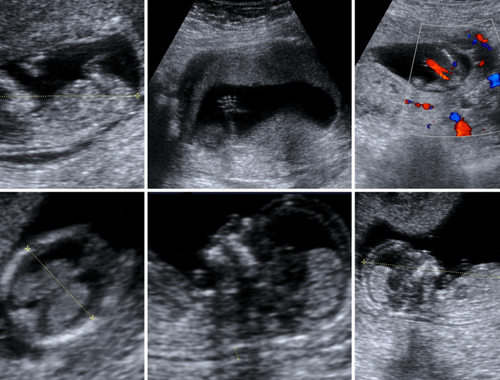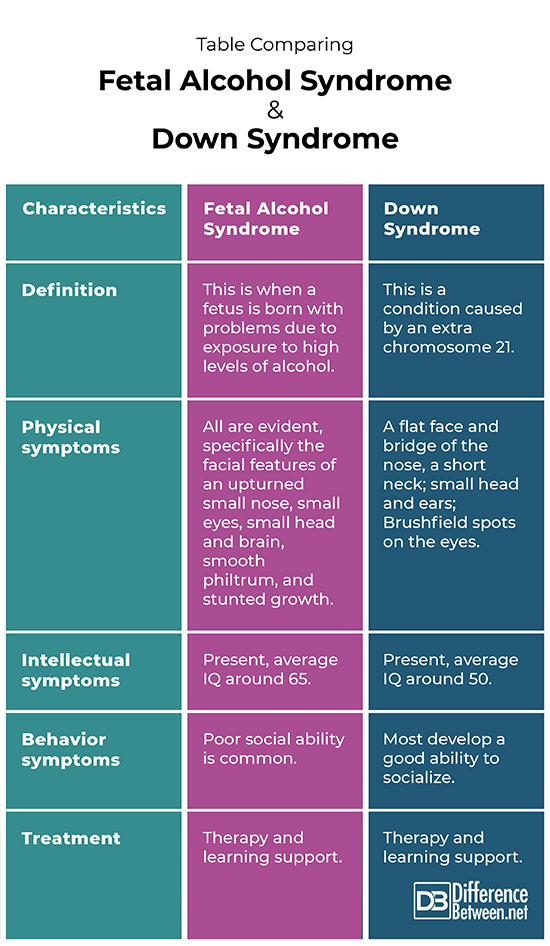Difference Between Fetal Alcohol Syndrome and Down Syndrome
Fetal alcohol syndrome is when a fetus is harmed in utero due to exposure to alcohol. Down syndrome is a genetic condition where there is an extra chromosome 21.

What is Fetal alcohol syndrome?
Definition:
Fetal alcohol syndrome (FAS) is the condition where a fetus is adversely affected because the mother has consumed high doses of alcohol during pregnancy. It occurs in roughly 0.3 to 1.0 children of 1000 births.
Symptoms:
Children who are born with FAS are often small in size and have distinctive facial features. They have a smooth area between the bottom of the nose and upper lip instead of a groove (this area where the groove is, is called the philtrum). They often also have smaller eyes and heads than normal. A small chin and a thin upper lip are also noticeable. FAS children also have intellectual problems. Behavior problems may also occur throughout the life of the child.
Diagnosis:
Diagnosis is based on a physical exam of the child, noting the physical, mental, and behavioral symptoms typical of the disorder. The facial and neurological problems or malformations, along with stunted growth and the mother’s history of drinking excessively while pregnant, are usually used to confirm FAS in the child.
Treatment:
There is not much that can be done to treat children born with FAS. However, it is recommended that such children receive support in school, where they may struggle to learn due to their cognitive deficits. Children with FAS may need therapy for their behavior problems.

What is Down syndrome?
Definition:
Down syndrome is a condition where a person is born with an extra chromosome 21.
Symptoms:
Children born with Down syndrome have specific physical attributes such as a flat face, flattened bridge of the nose, small head, eyes, and ears. They also have short necks and may experience problems with their heart, namely an atrioventricular septal defect. This heart defect results in blood mixing in the heart in a way that it should not. The lungs are often not as well developed in Down syndrome babies. They also have small white spots (Brushfield spots) on the eye. The eyes often slant up, and sometimes the tongue may tend to protrude from the mouth.
Diagnosis:
Down syndrome is usually diagnosed from a chorionic villus sampling (CVS) analysis. The way CVS is done is a bit of fluid with cells is carefully removed from the placenta before the baby is born. A chromosome study is then done where trisomy 21 (3 chromosomes at position 21) is detected.
Treatment:
Kids with Down syndrome can be taught many skills, and often they attend special schools. Occupational and physical therapy can also be helpful, as well as socialization.
Difference between Fetal alcohol syndrome and Down syndrome?
Definition
Fetal alcohol syndrome is when a fetus is born with problems due to exposure to high levels of alcohol. Down syndrome is a genetic condition where there is an extra chromosome.
Physical symptoms
The symptoms of FAS include the facial features of an upturned small nose, small eyes, small head and brain, smooth philtrum, and stunted growth. The features of Down syndrome include a flattened nose, small head and ears, slanted eyes, short neck, short stature, and sometimes lung and heart problems.
Intellectual symptoms
Children with FAS have an IQ of about 65. Children with Down syndrome have an IQ of about 50.
Behavior symptoms
Children with FAS have problems with behavior, such as not communicating properly or understanding social cues. Children with Down syndrome may struggle at first to communicate, but often, they are very sociable.
Treatment
Learning support and therapy can help children with FAS and children who have Down syndrome.
Table comparing Fetal alcohol syndrome and Down syndrome

Summary of Fetal alcohol syndrome Vs. Down syndrome
- Fetal alcohol syndrome is when a child is born with certain physical and mental features due to exposure to alcohol.
- Down syndrome is when a child is born with an extra chromosome, causing certain physical and mental problems.
FAQ
What is the difference between fetal alcohol syndrome and fetal alcohol effects?
Fetal alcohol syndrome is when a fetus is harmed because of exposure to alcohol. Fetal alcohol effects are when a child has mild symptoms of alcohol exposure.
Is fetal alcohol syndrome more common than Down syndrome?
Research suggests that fetal alcohol syndrome is now more common in children than is Down syndrome.
What are the 3 facial features of fetal alcohol syndrome?
A child who is born with fetal alcohol syndrome has a philtrum that is smooth, a thin upper lip and a short and upturned nose.
Is Down syndrome related to alcohol?
No, Down syndrome is a specific genetic mutation in which an extra chromosome is produced; this is why it is also called trisomy 23 because it is an extra 23rd chromosome. Down syndrome is not related to alcohol intake by the mother.
Can fetal alcohol syndrome be misdiagnosed?
Yes, it is possible that children with milder forms of the condition may not be diagnosed correctly. Diagnosis is even more difficult with fetal alcohol effects.
What are the 4 criteria necessary for a fetal alcohol syndrome diagnosis?
There are four general criteria used to diagnose FAS. These include malformations on the face, abnormalities of the central nervous system, the mother’s history of alcohol intake during pregnancy, and stunted growth.
How much do you have to drink to give your baby fetal alcohol syndrome?
A mother who has 13 alcoholic beverages in 30 days, or two drinks in one sitting, places her baby at risk of fetal alcohol syndrome. It is recommended that women do not drink any alcohol during pregnancy because the CDC maintains that no amount of alcohol is safe and any alcohol can damage the developing brain of the fetus.
How do they test for fetal alcohol syndrome?
Testing for fetal alcohol syndrome requires a test of mental capacity but also a review of the behavior of the child. The presence of certain facial features like a smooth philtrum and a small head and eyes, and an upturned nose, also can suggest FAS. Stunted growth is also a feature of FAS babies. A mother with a history of drinking during pregnancy also helps confirm the diagnosis of FAS.
- Difference Between Rumination and Regurgitation - June 13, 2024
- Difference Between Pyelectasis and Hydronephrosis - June 4, 2024
- Difference Between Cellulitis and Erysipelas - June 1, 2024
Search DifferenceBetween.net :
Leave a Response
References :
[0]CDC. “Facts about Down syndrome”. Centers for Disease Control and Prevention, 2022, https://www.cdc.gov/ncbddd/birthdefects/downsyndrome.html
[1]Dysart, Kevin C. “Fetal alcohol syndrome”. Merckmanuals. Merck & Co., 2022, https://www.msdmanuals.com/professional/pediatrics/metabolic,-electrolyte,-and-toxic-disorders-in-neonates/fetal-alcohol-syndrome
[2]Streissguth, Ann P., et al. "Risk factors for adverse life outcomes in fetal alcohol syndrome and fetal alcohol effects." Journal of Developmental & Behavioral Pediatrics 25.4 (2004): 228-238.
